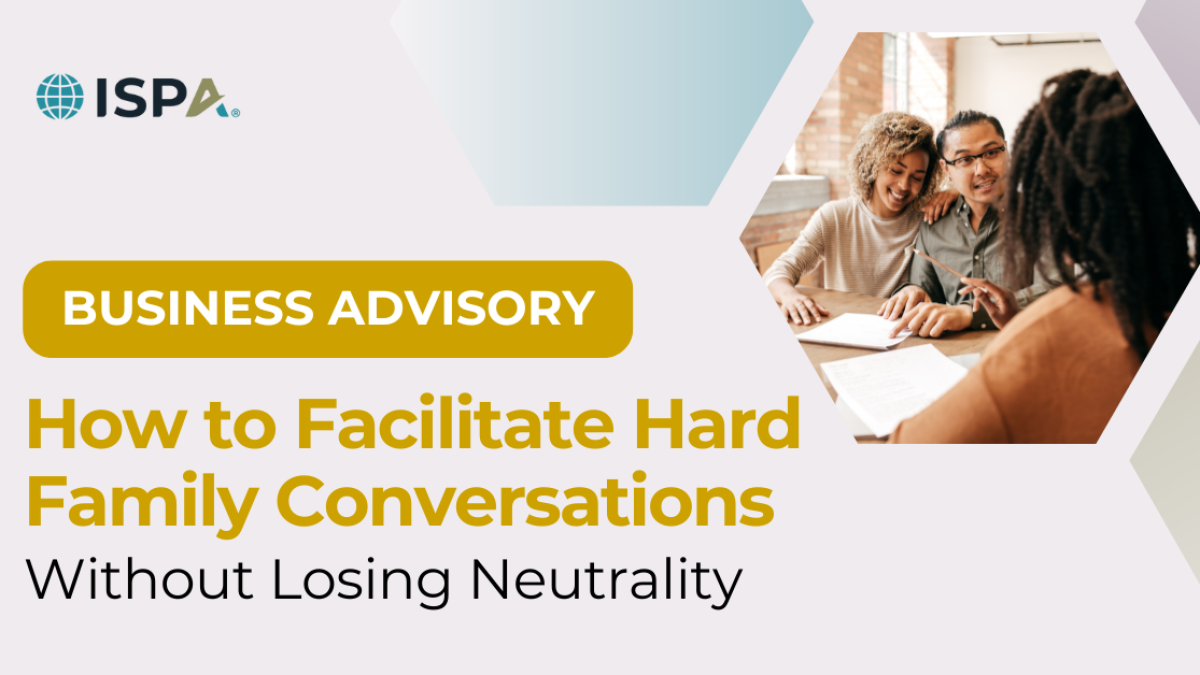How to Facilitate Hard Family Conversations Without Losing Neutrality

Learn how to facilitate difficult family business conversations with structure and neutrality using Succession Matrix® steps for clarity and progress.
You have likely been in a room where a father, daughter, or sibling stopped speaking mid-sentence. The silence feels heavy. Every word matters. You are expected to guide with calm and know how to facilitate difficult family business conversations without losing trust. Structure protects the process and keeps you steady when the conversation becomes emotional.
Quick Summary
Family discussions in succession planning include personal history and fear of change. This article shows how to facilitate difficult family business conversations with clear steps you can use in real meetings. You will learn techniques grounded in the Succession Matrix® that help you stay neutral, lower tension, and guide families toward aligned decisions.
For more information about the Succession Matrix®, see: The Succession Matrix®: Key Components to Succession, According to Study.
Why Family Conversations Need Structure
Family dynamics influence the pace, tone, and direction of every discussion. Even a simple question about responsibilities or timing can shift the mood when old patterns surface. Without a structured process, these discussions drift, personal comments increase, and clarity fades.
Structure provides clients with a means to distinguish today’s decision from yesterday’s history. It creates a consistent path that reduces anxiety for everyone in the room. Advisors who use a repeatable process set the tone for calm and collaborative decision-making.
Clear structure also supports advisors when conversations become emotional. Instead of reacting to conflict, you can redirect the group to the shared purpose of the meeting. This helps family members feel safe, heard, and respected. You are not controlling the outcome. You are guiding the way the conversation unfolds.
Two areas of the Succession Matrix® directly support strong family discussions:
- Family Harmony
- Teamwork
These areas remind advisors and families to focus on roles, responsibilities, and the working relationship required for long-term success.
For more context about emotional dynamics, explore how emotions influence the planning process.
How to Facilitate Difficult Family Business Conversations
The following steps help you lead conversations that stay grounded, respectful, and productive. They are practical, repeatable, and easy to apply with any family system.
Set Shared Expectations at the Start
Families feel more comfortable participating when they understand the structure of the conversation. A well-prepared opening sets the tone and gives everyone a moment to settle in.
During your opening, you guide the room by:
- Explaining your role as the facilitator
- Clarifying that you are neutral
- Describing the purpose of the meeting
- Setting simple time limits for sharing
- Highlighting the shared objective for the session
- Confirming how the group will define success today
These steps reduce tension because people understand the path forward. Structure is calming, especially when topics are sensitive.
When expectations are not aligned, meetings often lose focus early. Anxiety rises. Side conversations begin. People repeat themselves because they are unclear where the conversation is headed. A strong opening prevents these issues and promotes accountability.
Separate Roles From Relationships
Family members carry years of shared memories into every meeting. Without guidance, those histories influence how they interpret each comment or question. A simple business question becomes emotional when it feels connected to past experiences.
You help the family maintain clarity by keeping attention on responsibilities instead of relationships.
Useful questions include:
“Who owns this decision?”
“Who is responsible for the result?”
“What belongs to who?”
These questions separate emotional experiences from business roles. They reduce handling family tension and help people focus on the actual decision being made. When roles are clear, conversations become less defensive and more collaborative.
This also helps prevent assumptions. When family members try to infer what others think or feel, arguments rise quickly. Clear roles reduce those assumptions and keep the discussion on track.
Use Neutral, Respectful Language
Your communication style affects how clients respond. Simple, calm phrasing helps people feel safe sharing honest input. It also prevents misunderstandings during tense moments.
Neutral statements help guide the conversation:
“Let’s review this together.”
“Let’s take this one step at a time.”
“Let’s focus on what we know so far.”
These phrases support advisor neutrality and reduce escalation. You are not judging or correcting anyone. You are simply returning the discussion to the process.
Avoid phrasing that sounds accusatory or dismissive, such as:
“You are misunderstanding.”
“That is wrong.”
These comments often shut down participation or shift the focus to personal defensiveness.
For more ideas, explore 5 Ways to Build Trust as an Advisor.
Document Agreements Clearly
Meetings move quickly. When multiple family members share concerns, questions, or updates, details can become easily confused. Written summaries provide clarity and prevent disagreements later.
At the close of each meeting, capture:
- Decisions made
- Tasks assigned
- Deadlines
- Open questions
- Next steps
- Who owns each responsibility
Send the summary to everyone. This reinforces alignment and reduces the need for repeated clarification. It also builds professional credibility. Families appreciate when advisors stay organized, objective, and consistent.
Case Example: A Family Working Toward Alignment
A family business with two siblings in leadership struggled with decision-making. Their discussions often became personal, and both siblings felt unheard. This created unnecessary delays and negatively impacted morale within the company.
The advisor introduced structure using concepts from the Succession Matrix®. Each meeting began with a clear agenda and ended with written agreements. When tension rose, the advisor paused and returned the group to their shared goal.
The siblings eventually developed better habits. They learned to express their opinions without resorting to personal attacks and began listening to each other with greater patience. The advisor helped them develop communication practices that supported both their family relationship and their business.
Staying Neutral When Emotions Rise
Emotion is a natural part of family business discussions. Advisors who remain calm help families feel grounded and supported. Neutrality builds trust and strengthens your professional relationship.
Before each meeting, prepare by identifying:
- Each person’s main goal
- Areas where flexibility exists
- The decisions that need attention today
- Topics that may create tension
- The easiest next step for the group
This preparation helps you stay focused when emotions rise. During the meeting, use neutral redirect phrases:
“Let’s pause and return to our shared goal.”
“Let’s take this one step at a time.”
These simple cues protect your neutrality and help the family continue making progress. They also reinforce the Succession Matrix® areas of Family Harmony and Teamwork, which support consistent communication and clear expectations.
Continuing education strengthens these skills. The Certified Succession Planner® program gives you structured tools and reinforces steady facilitation. The ISPA Community offers support as you apply these methods with real clients.
Key Takeaways
- Structure keeps conversations organized and reduces emotional reactions.
- Clear expectations help families feel more comfortable sharing their thoughts.
- Neutral language supports advisor neutrality and steady communication.
- Written summaries prevent confusion and protect the process.
- You strengthen your practice when you understand how to facilitate difficult family business conversations with clarity and confidence.
Strengthen Your Facilitation Skills
Improve your approach to sensitive openings.
Watch the session: The Art of the First Conversation: How to Start Strong with Business Owners.
Advance your advisory practice.
Enroll in Certified Succession Planner® Certification or join the ISPA for training, tools, and advisor support.
FAQs About Facilitating Difficult Family Business Conversations
Q: What is the best way to start learning how to facilitate difficult family business conversations?
The best starting point is a clear, repeatable process. Begin by setting expectations and identifying the shared goal. Use neutral phrases to guide the discussion and reduce tension. Training programs give you practical structure you can apply immediately with clients.
Q: How do advisors stay neutral when facilitating family business conversations?
Advisors stay neutral by preparing ahead of time, redirecting emotional moments back to the shared purpose, and maintaining focus on responsibilities rather than relationships. When facilitating family business conversations, neutrality comes from consistency, clarity, and steady communication.
Q: Why is advisor neutrality important in emotional family meetings?
Neutrality builds trust and keeps the conversation focused on decisions that move the business forward. Families feel safe sharing concerns when the advisor stays steady. Advisor neutrality reduces conflict, fosters honest dialogue, and leads to more effective outcomes for everyone involved.
Categories: : Family Dynamics, Matrix
GROW YOUR ADVISORY PRACTICE WITH THE ISPA
Seamlessly implement cutting-edge tools and strategies for business advisory and succession planning. Focus on delivering tangible results that foster your clients' success and drive growth in your own business.
Are You Looking to Grow Your Practice?
Check Out These Free Downloads

16 HIDDEN BUSINESS OPPORTUNITIES
Multi-generational clients grow your business. Whether you are a lawyer, accountant, financial advisor, or consultant, we have a list of actionable strategies you can test today to motivate your clients to work with you long term.

12 QUESTIONS TO CREATE CLIENT OPPORTUNITIES
In this free resource of 12 powerful questions you can ask to identify client motivations and influence business owners to take action. You will have a better discussion with prospects & clients immediately.

20 YEAR
CASE STUDY
Want to get into the specifics of what it takes in succession planning? Gain insights into the inner-workings of a real long-term family business succession planning case study and a business engagement that was worth over $75,000 per year.

3 STRATEGIC PROJECT EXAMPLES
We outlined three of our best examples of projects you could learn from and potentially apply in your business. From objective to successful outcome, these family business examples help you build strategies.
JOIN OUR INSIDER UPDATES FOR EXCLUSIVE INSIGHTS
Access premium resources at no cost. Gain insights into cutting-edge strategies for client acquisition and retention, along with exclusive webinars designed to advance your advisory practice. Subscribe to our Insight Briefs and amplify your advisory impact.
 Succession Planning Resource
Succession Planning Resource 


